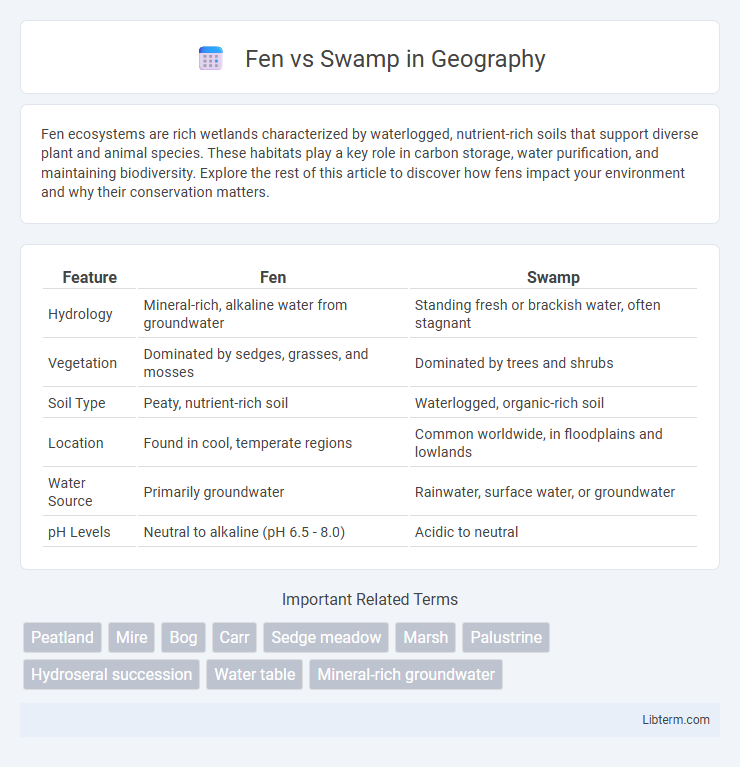Fen ecosystems are rich wetlands characterized by waterlogged, nutrient-rich soils that support diverse plant and animal species. These habitats play a key role in carbon storage, water purification, and maintaining biodiversity. Explore the rest of this article to discover how fens impact your environment and why their conservation matters.
Table of Comparison
| Feature | Fen | Swamp |
|---|---|---|
| Hydrology | Mineral-rich, alkaline water from groundwater | Standing fresh or brackish water, often stagnant |
| Vegetation | Dominated by sedges, grasses, and mosses | Dominated by trees and shrubs |
| Soil Type | Peaty, nutrient-rich soil | Waterlogged, organic-rich soil |
| Location | Found in cool, temperate regions | Common worldwide, in floodplains and lowlands |
| Water Source | Primarily groundwater | Rainwater, surface water, or groundwater |
| pH Levels | Neutral to alkaline (pH 6.5 - 8.0) | Acidic to neutral |
Introduction to Fens and Swamps
Fens and swamps are both types of wetlands characterized by saturated soils and unique ecosystems. Fens are peat-forming wetlands fed primarily by groundwater, resulting in nutrient-rich, alkaline conditions that support diverse plant species such as sedges and grasses. Swamps, in contrast, are forested wetlands dominated by trees and shrubs, typically found in freshwater environments with slower water movement and higher nutrient levels.
Defining Characteristics of Fens
Fens are peat-forming wetlands characterized by their alkaline, nutrient-rich waters fed by groundwater, resulting in a unique plant community dominated by sedges, grasses, and wildflowers. Unlike swamps, which are dominated by woody plants and have acidic, nutrient-poor water from surface runoff, fens support higher biodiversity due to their sustained mineral input. The presence of fen-specific bryophytes and slow decomposition rates further distinguish fens, fostering a distinct ecological environment critical for carbon storage and specialized wildlife.
Key Features of Swamps
Swamps are wetlands characterized by saturated soils and standing water, often dominated by woody vegetation such as trees and shrubs, which differentiates them from fens that are primarily peat-forming and rich in sedges and grasses. Swamps typically have nutrient-rich, acidic conditions supporting diverse wildlife habitats, including amphibians, birds, and aquatic plants adapted to fluctuating water levels. Their complex root systems help stabilize the soil and improve water quality by filtering pollutants, making swamps vital for flood control and ecosystem health.
Water Sources and Hydrology
Fens derive their water primarily from mineral-rich groundwater or surface water, leading to neutral to alkaline pH levels, while swamps are dominated by standing or slow-moving surface water, often with acidic conditions due to organic matter accumulation. The hydrology of fens is characterized by continuous water flow and nutrient influx, maintaining saturated but well-oxygenated soils. In contrast, swamps experience periodic flooding and water stagnation, promoting anaerobic soil conditions and distinct vegetation adapted to fluctuating water levels.
Soil Composition and Chemistry
Fens feature alkaline, nutrient-rich soils with high concentrations of calcium and magnesium, supporting diverse plant species adapted to less acidic conditions. Swamps typically have acidic, waterlogged soils abundant in organic matter and low oxygen levels, which influence the prevalence of hydrophilic vegetation like cypress and mangroves. The contrasting soil chemistry between fens and swamps shapes their distinct ecosystems and biodiversity.
Plant Life: Fens vs Swamps
Fens support a diverse array of sedges, grasses, and wildflowers adapted to alkaline, nutrient-rich conditions, including species like Carex and Menyanthes trifoliata. Swamps predominantly feature water-tolerant trees such as cypress and tupelo, alongside shrubs and aquatic plants adapted to acidic, nutrient-poor environments. The contrast in plant communities between fens and swamps reflects their distinct hydrology and soil chemistry, influencing biodiversity and ecosystem function.
Wildlife Habitats and Biodiversity
Fens support diverse plant species and unique wildlife adapted to alkaline, nutrient-rich conditions, including sedges, orchids, and various amphibians. Swamps feature dense woody vegetation and standing water, providing critical habitats for birds such as herons, amphibians, and mammals like beavers. Both wetlands contribute significantly to biodiversity by sustaining distinct ecosystems crucial for many specialized species.
Ecological Importance and Services
Fens and swamps both provide critical ecosystem services, including water filtration and habitat provision, with fens supporting diverse plant species due to their alkaline, nutrient-rich waters. Swamps offer substantial carbon sequestration through their dense woody vegetation and act as natural flood buffers, protecting surrounding areas from storm surges. These wetlands maintain biodiversity by supporting specialized flora and fauna adapted to wet conditions, vital for ecological stability.
Threats and Conservation Challenges
Fens face significant threats from nutrient pollution and hydrological alterations caused by agricultural runoff and drainage systems, leading to loss of biodiversity and altered plant communities. Swamps are endangered by urban development, invasive species, and changes in water levels due to dam construction and water extraction, which disrupt the delicate ecosystem balance. Both wetlands require targeted conservation strategies addressing water quality, habitat restoration, and invasive species management to ensure their survival and ecological function.
Fen and Swamp Restoration Efforts
Fen restoration efforts prioritize reestablishing natural hydrology by blocking drainage ditches and maintaining groundwater flow to support specialized plant communities and peat accumulation. Swamp restoration focuses on restoring natural water levels and promoting native tree species regeneration to enhance habitat complexity and biodiversity. Both ecosystems benefit from targeted invasive species removal and long-term monitoring to ensure ecological resilience.
Fen Infographic

 libterm.com
libterm.com